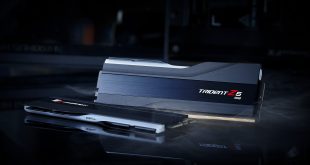With memory modules of this calibre, it is fair to assume that a large proportion of the user base will be looking for the kit's highest attainable frequency with good enough stability. That doesn't mean that the ability for the overclocked kit to run every benchmark with stability is crucial, but it does place an importance on being able to boot and run at least one test flawlessly.
We will be tweaking the base clock to fine-tune the memory overclock. Due to the above point, and the fact that the processor frequency will be different to when the RAM was running at stock speeds, there is little point in showing comparison benchmarks. Instead, we will use a single run of Super Pi 16M to verify stability.
After breezing past the 2933MHz divider, we opted for the 1.25x CPU strap so that we could use a BCLK around the 125MHz-mark for our overclocking attempts. The 1.00x CPU strap would require the maximum Haswell memory multiplier and a high base clock which may have limited the sticks’ overclocking headroom.
To eliminate base clock bottlenecks, we used a number of increased voltages for the CPU and system. With each increase in the base clock, the CPU multiplier was dropped to a level which put the frequency near its stock level.
The tweaks applied included a 1.7015V DRAM voltage, various CPU voltage increases and setting changes for BCLK overclocking stability, and a CPU input voltage of 1.900V. ASRock’s automated settings proved favourable for overclocking performance and didn’t require changing.
The highest DRAM frequency we managed to achieve using stock timings was 3024MHz. This consisted of a 126MHz BCLK and 18x memory multiplier (while also using the 100:133 BCLK:DRAM frequency ratio).
3024MHz is a strong result for an already high-speed kit. The 224MHz speed bump didn't require much more work than the effort taken to tweak a few voltage settings.
Our system validation with the Kingston HyperX Predator modules running at 3024MHz with stock timings can be viewed here.
Timings were loosened to 14-15-15-40-2T in an attempt to attain the highest possible DRAM frequency.
The highest Super Pi 16M-stable memory overclock that we achieved with the Kingston HyperX Predator memory modules was 3136MHz. This consisted of a 168MHz base clock, 100:133 BCLK:DRAM frequency ratio, and a 14x memory divider.
Our quick run of tests showed this overclock to be relatively stable in a Windows environment. As always, though, we wouldn't call an overclock 24/7 stable without completing the necessary long-term stability testing procedures.
We made multiple attempts to boot at a higher memory speed, but it was clear that 3136MHz was the highest frequency that our specific sample was capable of when partnered with our test hardware and configuration.
Our validation running at a 3136MHz DRAM frequency can be viewed here.
 KitGuru KitGuru.net – Tech News | Hardware News | Hardware Reviews | IOS | Mobile | Gaming | Graphics Cards
KitGuru KitGuru.net – Tech News | Hardware News | Hardware Reviews | IOS | Mobile | Gaming | Graphics Cards











Great review Luke, but I do have a little disagreement over the oversized heatspreaders. there is never any need for these – a good airflow case is more than enough. Green PCB is a bad move too as you say,
They cause so many issues with CPU coolers.